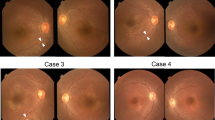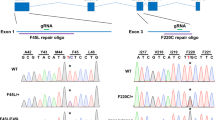Abstract
The metabolic pathways that produce 11-cis retinal are important for vision because this retinoid is the chromophore residing in rhodopsin and the cone opsins. The all-trans retinal that is generated after cone and rod photopigments absorb photons of light is recycled back to 11-cis retinal by the retinal pigment epithelium and Müller cells of the retina. Several of the enzymes involved have recently been purified and molecularly cloned1,2,3; here we focus on 11-cis retinol dehydrogenase (encoded by the gene RDH5; chromosome 12q13-14; ref. 4), the first cloned enzyme in this pathway. This microsomal enzyme is abundant in the retinal pigment epithelium5, where it has been proposed to catalyse the conversion of 11-cis retinol to 11-cis retinal. We evaluated patients with hereditary retinal diseases featuring subretinal spots (retinitis punctata albescens and fundus albipunctatus) and patients with typical dominant or recessive retinitis pigmentosa for mutations in RDH5. Mutations were found only in two unrelated patients, both with fundus albipunctatus; they segregated with disease in the respective families. Recombinant mutant 11-cis retinol dehydrogenases had reduced activity compared with recombinant enzyme with wild-type sequence. Our results suggest that mutant alleles in RDH5 are a cause of fundus albipunctatus, a rare form of stationary night blindness characterized by a delay in the regeneration of cone and rod photopigments.
This is a preview of subscription content, access via your institution
Access options
Subscribe to this journal
Receive 12 print issues and online access
$209.00 per year
only $17.42 per issue
Buy this article
- Purchase on Springer Link
- Instant access to full article PDF
Prices may be subject to local taxes which are calculated during checkout





Similar content being viewed by others
References
Simon, A., Hellman, U., Wernstedt, C. & Eriksson, U. The retinal pigment epithelial-specific 11-cis retinol dehydrogenase belongs to the family of short chain alcohol dehydrogenases. J. Biol. Chem. 270, 1107–1112 (1995).
Haeseleer, F., Huang, J., Lebioda, L., Saari, J.C. & Palczewski, K. Molecular characterization of a novel short-chain dehydrogenase/reductase that reduces all-trans-retinal. J. Biol. Chem. 273, 21790–21799 (1998).
Ruiz, A. et al. Molecular and biochemical characterization of lecithin retinol acyltransferase. J. Biol. Chem. 274, 3834–3841 (1999).
Simon, A., Lagercrantz, J., Bajalica-Lagercrantz, S. & Eriksson, U. Primary structure of human 11-cis retinol dehydrogenase and organization and chromosomal localization of the corresponding gene. Genomics 36, 424–430 (1996).
Simon, A., Romert, A., Gustafsson, A.-L., McCaffrey, J.M. & Eriksson, U. Intracellular localization and membrane topology of 11-cis retinol dehydrogenase in the retinal pigment epithelium suggest a compartmentalized synthesis of 11-cis retinaldehyde. J. Cell Sci. 112, 549–558 (1999).
Wang, J., Chai, X.Y., Eriksson, U. & Napoli, J.L. Activity of human 11-cis retinol dehydrogenase (Rdh5) with steroids and retinoids and expression of its mRNA in extra-ocular human tissue. Biochem. J. 338, 23–27 (1999).
Carr, R.E., Ripps, H. & Siegel, I.M. Visual pigment kinetics and adaptation in fundus albipunctatus. Doc. Ophthal. Proc. Series 4, 193–204 (1974).
Marmor, M.F. Defining fundus albipunctatus. Doc. Ophthal. Proc. Series 13, 227–233 (1976).
Ripps, H. Night blindness revisited: from man to molecules. Proctor lecture. Invest. Ophthalmol. Vis. Sci. 23, 588–609 (1982).
Morimura, H., Berson, E.L. & Dryja, T.P. Recessive mutations in the gene encoding cellular retinaldehyde-binding protein in a form of retinitis punctata albescens. Invest. Ophthalmol. Vis. Sci. 40, 1000–1004 (1999).
Green, S., Issemann, I. & Sheer, E. A versatile in vivo and in vitro expression vector for protein engineering. Nucleic Acids Res. 16, 369 (1988).
Kunkel, T.A., Roberts, J.D. & Zakour, R.A. Rapid and efficient site-specific mutagenesis without phenotypic selection. Methods Enzymol. 154, 367–382 (1987).
Vieira, J. & Messing, J. Production of single-stranded plasmid DNA. Methods Enzymol. 153, 3–11 (1987).
Romert, A., Tuvendal, P., Simon, A., Dencker, L. & Eriksson, U. The identification of a 9-cis retinol dehydrogenase in the mouse embryo reveals a pathway for synthesis of 9-cis retinoic acid. Proc. Natl Acad. Sci. USA 95, 4404–4409 (1998).
Berson, E.L., Gouras, P. & Gunkel, R.D. Rod responses in retinitis pigmentosa, dominantly inherited. Arch. Ophthalmol. 80, 58–67 (1968).
Berson, E.L. Retinitis pigmentosa and allied retinal diseases: electrophysiologic findings. Trans. Am. Acad. Ophthalmol. Otolaryngol. 81, 659–666 (1976).
Acknowledgements
We thank B. Åkerblom and T. McGee for expert technical assistance; J.-O. Höög for helpful discussions; and U. Bergman and A. Tuuttila for help with the HPLC analyses. This work was supported by grants from the NIH (EY08683, EY00169) and the Foundation Fighting Blindness, and by the Swedish Medical Research Council (K99-03P-12070-03C, U.E.). The cooperative research agreement between the Ludwig Institute for Cancer Research/Stockholm Branch and Fuji Photo Film (Europe) is gratefully acknowledged.
Author information
Authors and Affiliations
Corresponding author
Rights and permissions
About this article
Cite this article
Yamamoto, H., Simon, A., Eriksson, U. et al. Mutations in the gene encoding 11-cis retinol dehydrogenase cause delayed dark adaptation and fundus albipunctatus. Nat Genet 22, 188–191 (1999). https://doi.org/10.1038/9707
Received:
Accepted:
Issue Date:
DOI: https://doi.org/10.1038/9707
This article is cited by
-
Novel variants in the RDH5 Gene in a Chinese Han family with fundus albipunctatus
BMC Ophthalmology (2022)
-
Acquired night blindness due to rod dysfunction after long-term hemodialysis
Japanese Journal of Ophthalmology (2022)
-
The genetics of rod-cone dystrophy in Arab countries: a systematic review
European Journal of Human Genetics (2021)
-
Vitamin A deficiency after prolonged intake of an unbalanced diet in a Japanese hemodialysis patient
Documenta Ophthalmologica (2021)
-
Unraveling the genetic cause of hereditary ophthalmic disorders in Arab societies from Israel and the Palestinian Authority
European Journal of Human Genetics (2020)



